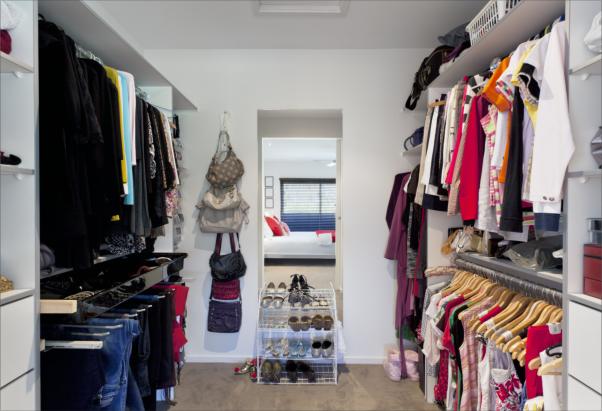
For most people the ideal closet is the size of a room with ample space to hang clothing, lots of shelves to tuck and stash away things — a place where you can walk around and assess all your personal belongings.
In reality, most people’s closets fall well short of this ideal. And few of us stop to consider the full potential of the closets we do have — tiny as they may be. To understand their true potential, take a good objective look inside the closets you already have — and the empty spaces that could be turned into closets or cupboards.
Closets are not the sort of thing most of us like to face. By their very nature, they invite us to avoid them. As long as the living space looks good, what’s inside the closets doesn’t really matter. It is said that both home and self improvement often start with your closets. The more effective and organized your closets are, the more effective and organized you feel.
The main things to consider when organizing your closets are budget, space and lifestyle. Even the tiniest closet can be maximized, and not necessarily at a high price.
Also, the contents of a closet don’t necessarily have to fit the contents of a room. A hall broom closet can be turned into a pantry; a kitchen nook can be turned into a place to hang a wardrobe.
And you don’t have to just hang things in closets. You can add shelf units, baskets, bins, or whatever fits, to store things in. Consider an air plane, a boat or a mobile home, where space is at a premium. Storage spaces are found above, below and to all sides of furnishings.
Here are a few more ideas to consider:
- Make your closets serve a variety of purposes. Try adding a shelving unit to a clothes closet where you can store pantry goods and other items.
- Always try to incorporate a variety of shelving units in a closet. These give you space to store small items such as shoes, scarves, handbags and even books.
- The ceiling space in closets is seldom used. Consider adding a shelve or a compartment to store bulkier items such as luggage or blankets.
- Before re-organizing a closet, take everything out. Set aside anything you haven’t worn or used in a year. Consider donating these items to charity. Those you no longer use but want to keep should be stored separately in the attic or some place out of the way. Clearing out a closet is the first step in creating more space.
- Invest in a shoe rack that can be incorporated into your closet. Whether it sits on the floor or hangs from the door or is part of a shelve unit, a rack will not only keep your shoes together it will give the whole closet a more organized appearance.
- Plan to store your out-of-season clothes out of the way in boxes or elsewhere. Use the closet only to keep those items you wear regularly during a season.
- If you dislike the smell of mothballs but want to ensure your closets smell nice and don’t attract moths, try hanging a sachet of dried rosemary flowers or a mixture of cinnamon and cloves. There are many fresh-smelling deodorizers and perfumed papers to choose from on the market as well.
- If closet space is still tight and there are few open spaces in your home that can be turned into closets, try adding an armoire or wardrobe. This was the furniture piece used for storing clothes back when there weren’t built-in closets. It’s still a popular and practical item in many homes today.
- Try turning an entire wall in a room into a storage area. There are many systems available that can be easily installed. You can close them up by adding doors, or keep them open and airy.
- Kitchens are where you can be most creative in finding extra storage space. To get the best use of kitchen closet space, store as much as possible outside the closets. That means hanging anything that can hang from the ceilings and the walls. Custom-design closets and cupboards for the specific goods each will hold. This may include drawers for knives, shelves for different size cans, jars, etc.
- Adding a shelving rack to the inside of a closet door can make even the shallowest closet seem deeper.
- In a child’s room, don’t limit yourself to the space inside the closet. Use lots of bins, stacking baskets and shelving units throughout the room to store and toss things in.
Source: Ontario Real Estate Association
